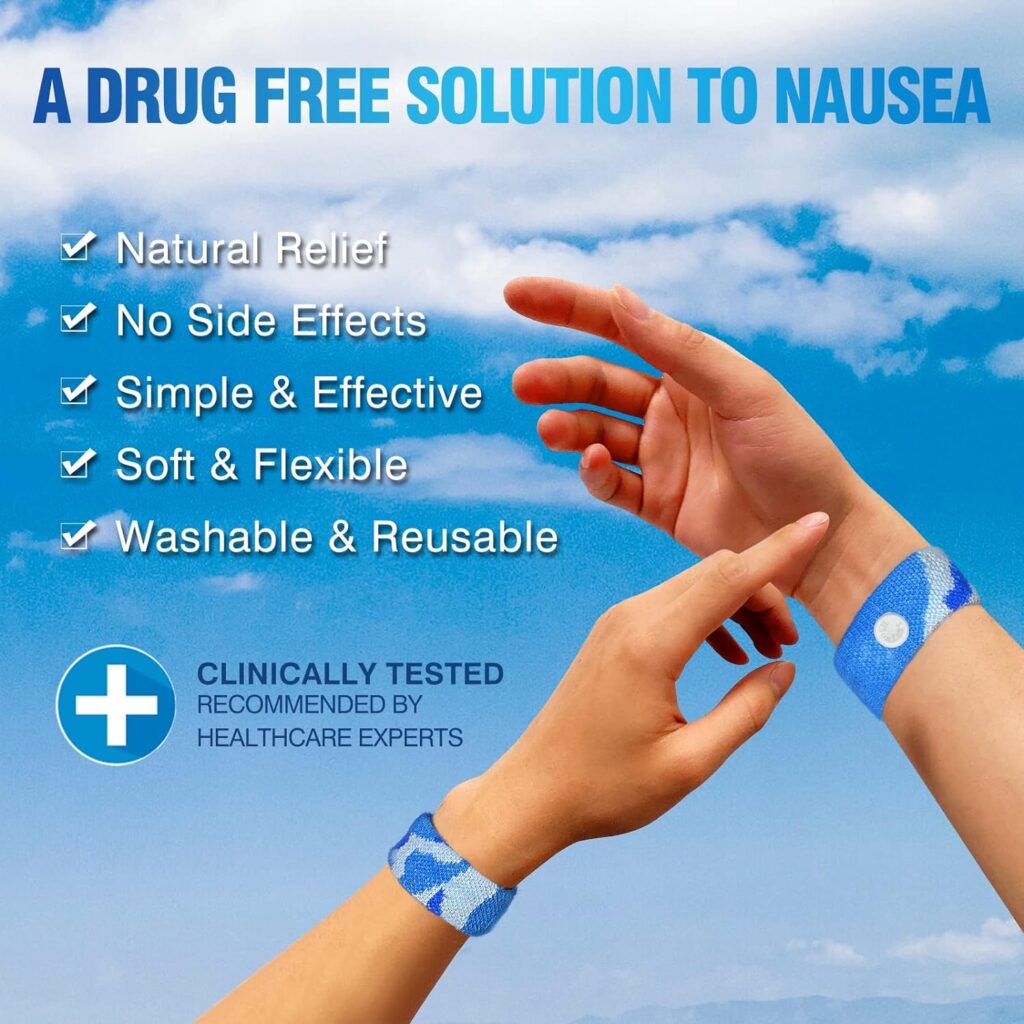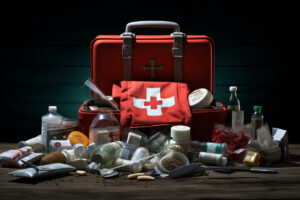Going on a cruise can be a wonderful experience, but it can also be ruined by seasickness. It can cause symptoms such as nausea, vomiting, dizziness, headache, and fatigue. But with so many options available, how do you choose the best seasick medicine for cruise? In this article, we will compare and contrast some of the most popular brands and types of seasickness medicine for cruise, and provide some tips and recommendations on how to use them safely and effectively.
Table of Contents
Types of the Best Seasick Medicine for Cruise
There are two main types of seasickness medicine for cruise: over-the-counter (OTC) and prescription. OTC medicines are those that you can buy without a doctor’s prescription from a pharmacy, a supermarket, or online. Prescription medicines are those that you need a doctor’s prescription to buy from a pharmacy. Both types of medicines have their advantages and disadvantages, depending on your personal preferences and needs.
Over-the-Counter (OTC) Seasickness Medicine for Cruise
OTC seasickness medicines are usually antihistamines, which are drugs that block the effects of histamine, a chemical that causes allergic reactions in your body. Antihistamines can also reduce the activity of your vestibular system, which is the part of your inner ear that controls your balance and motion perception. By doing so, antihistamines can prevent or relieve the symptoms of seasickness.
Some of the most common OTC seasickness medicines for cruise are:
- Dramamine: Dramamine is one of the most popular and widely used brands of OTC seasickness medicine for cruise. It contains dimenhydrinate, an antihistamine that can prevent and treat nausea, vomiting, and dizziness caused by motion sickness. Dramamine comes in different forms, such as tablets, chewables, liquids, and patches. It also has different formulas, such as original, non-drowsy, natural (with ginger), and kids. Dramamine is effective and easy to use, but it can also cause side effects such as drowsiness, dry mouth, blurred vision, and constipation.
- Bonine: Bonine is another well-known brand of OTC seasickness medicine for cruise. It contains meclizine hydrochloride, an antihistamine that can prevent and treat nausea, vomiting, and dizziness caused by motion sickness. Bonine comes in chewable tablets that have a fruity flavor. It also has a formula for kids. Bonine is effective and convenient, but it can also cause side effects such as drowsiness, dry mouth, headache, and vomiting.
- Benadryl: Benadryl is another common brand of OTC seasickness medicine for cruise. It contains diphenhydramine hydrochloride, an antihistamine that can prevent and treat nausea, vomiting, and dizziness caused by motion sickness. Benadryl comes in capsules, tablets, liquids, and creams. It also has formulas for allergy relief and sleep aid. Benadryl is effective and versatile, but it can also cause side effects such as drowsiness, dry mouth, blurred vision, and constipation.
The advantages of OTC seasickness medicines for cruise are:
- They are widely available and accessible
- They are relatively cheap and cost-effective
- They are easy to use and administer
- They are proven to work for most people
The disadvantages of OTC seasickness medicines for cruise are:
- They can cause side effects such as drowsiness, dry mouth, blurred vision, constipation, headache, and vomiting
- They can interact with other medications or substances, such as alcohol, antidepressants, or anticoagulants
- They can lose their effectiveness over time or with repeated use
- They can mask the underlying causes or symptoms of seasickness, such as dehydration, fatigue, or anxiety
Prescription Seasickness Medicine for Cruise
Prescription seasickness medicines are those that you need a doctor’s prescription to buy from a pharmacy. These medicines are usually stronger and more effective than OTC medicines, but they may also have more side effects and restrictions. The most common prescription seasickness medicine for cruise is:
- Scopolamine patch (Transderm Scop): Scopolamine patch is a prescription seasickness medicine for cruise that contains scopolamine, a drug that blocks the action of acetylcholine, a neurotransmitter that regulates your vestibular system. Scopolamine patch is applied behind your ear and delivers a steady dose of scopolamine through your skin for up to three days. Scopolamine patch can prevent and treat nausea, vomiting, and dizziness caused by motion sickness. Scopolamine patch is effective and long-lasting, but it can also cause side effects such as dry mouth, blurred vision, drowsiness, confusion, and hallucinations.
The advantages of prescription seasickness medicine for cruise are:
- They are more potent and reliable than OTC medicines
- They are longer-lasting and require less frequent administration than OTC medicines
- They are more suitable for severe or chronic cases of seasickness
The disadvantages of prescription seasickness medicine for cruise are:
- They require a doctor’s prescription and consultation to obtain and use
- They are more expensive and less accessible than OTC medicines
- They can cause more serious side effects and complications than OTC medicines
- They can have more contraindications and interactions with other medications or conditions than OTC medicines
Non-Drug Remedies for Seasickness

Besides taking seasickness medicine for cruise, you can also try some non-drug remedies to prevent or treat seasickness. These remedies are natural, safe, and inexpensive, but they may not be as effective or consistent as medicines. Some of the most popular non-drug remedies for seasickness are:
- Ginger: Ginger is a natural remedy that has anti-inflammatory and anti-nausea properties. It can help settle your stomach and reduce the symptoms of seasickness. You can consume ginger in various forms, such as fresh, dried, candied, powdered, or in tea, capsules, or lozenges. Ginger is effective and easy to use, but it can also cause side effects such as heartburn, gas, or diarrhea.
- Acupressure wristbands: Acupressure wristbands are devices that apply pressure to a specific point on your wrist called the P6 or Nei Guan point. This point is believed to regulate the flow of qi or energy in your body and balance your vestibular system. Acupressure wristbands can help prevent and treat nausea, vomiting, and dizziness caused by motion sickness. Acupressure wristbands are effective and convenient, but they can also cause side effects such as skin irritation, bruising, or numbness.
- Keeping a fixed gaze on the horizon: Keeping a fixed gaze on the horizon is a simple technique that can help reduce the conflict between your eyes and your inner ear. By looking at a stable point in the distance, you can align your visual input with your vestibular input and minimize the symptoms of seasickness. Keeping a fixed gaze on the horizon is effective and free, but it can also be difficult or impractical to do depending on the weather, the visibility, or the location.
- Staying hydrated: Staying hydrated is an important measure that can help prevent and treat seasickness. Dehydration can worsen the symptoms of seasickness by causing headaches, fatigue, or low blood pressure. Drinking enough water or fluids can help replenish your body’s fluids and electrolytes and improve your circulation and metabolism. Staying hydrated is effective and essential, but it can also be challenging or inconvenient to do depending on the availability or quality of water or beverages on board.
- Avoiding alcohol and tobacco: Avoiding alcohol and tobacco is a sensible advice that can help prevent and treat seasickness. Alcohol and tobacco can aggravate the symptoms of seasickness by dehydrating your body, irritating your stomach, or affecting your brain chemistry. Abstaining from alcohol and tobacco can help reduce your risk or severity of seasickness and improve your overall health and well-being. Avoiding alcohol and tobacco is effective and beneficial, but it can also be hard or unpleasant to do depending on your habits or preferences.
- Choosing a cabin located midship on the lower decks: Choosing a cabin located midship on the lower decks is a strategic decision that can help prevent and treat seasickness. The midship area of the ship is where the motion is least felt, as it is closer to the center of gravity and the motion is least felt, as it is closer to the center of gravity and the pivot point of the ship. The lower decks are also where the motion is less felt, as they are closer to the water level and the buoyancy force. Choosing a cabin in these areas can help reduce your exposure to the rocking and rolling of the ship and minimize the symptoms of seasickness. Choosing a cabin located midship on the lower decks is effective and comfortable, but it can also be expensive or limited to do depending on the availability or price of the cabins.
Special Considerations for Seniors
Seniors may have different needs and preferences when it comes to choosing the best seasick medicine for cruise. Seniors may be more sensitive or susceptible to the effects or side effects of seasickness medicine, as they may have lower metabolism, weaker immunity, or other medical conditions. Seniors may also have more difficulty or inconvenience in obtaining or using seasickness medicine, as they may have limited mobility, vision, or memory. Therefore, seniors should consider the following factors when choosing the best seasick medicine for cruise:
- Consult your doctor: The most important step for seniors is to consult your doctor before taking any seasickness medicine for cruise. Your doctor can advise you on the best type and dosage of seasickness medicine for your health condition and history. Your doctor can also prescribe you the appropriate seasickness medicine for cruise, or adjust your existing medications if needed. Your doctor can also provide you with a medical certificate or a letter of authorization if you need to carry prescription seasickness medicine for cruise.
- Choose a suitable type and dosage of seasickness medicine: Seniors should choose a type and dosage of seasickness medicine that suits their needs and preferences. For example, seniors may prefer non-drowsy or natural formulas of OTC seasickness medicine, such as Dramamine Non-Drowsy Naturals (with ginger) or Bonine Chewable Tablets (with meclizine). Seniors may also prefer patches or liquids over tablets or capsules, as they may be easier to apply or swallow. Seniors should also follow the instructions and guidelines on the label or package of the seasickness medicine, or consult their doctor or pharmacist for advice. Seniors should also avoid taking more than the recommended dose or frequency of the seasickness medicine, as this may cause adverse effects or complications.
- Pack enough supply and store them properly: Seniors should pack enough supply of seasickness medicine for cruise and store them properly. Seniors should pack their seasickness medicine in a clear, zippered bag that is easy to access and identify. Seniors should also label their bag with their name, cabin number, and emergency contact information. Seniors should pack their bag in their carry-on luggage if possible, as it may be inspected by security or delayed by luggage delivery. Seniors should also keep a list of their seasickness medicine and their dosages, as well as a copy of their prescriptions and a doctor’s note for hassle-free travel. Seniors should also check the expiration dates of their seasickness medicine before they pack them. Seniors should dispose of any expired or damaged items and replace them with new ones. Seniors should also check the storage instructions of their seasickness medicine before they pack them. Seniors should store them in a cool, dry, and dark place away from heat, moisture, and sunlight. Seniors should use insulated containers or ice packs if needed.
- Use non-drug remedies as well: Seniors should use non-drug remedies as well as seasickness medicine for cruise to prevent or treat seasickness. Non-drug remedies are natural, safe, and inexpensive, but they may not be as effective or consistent as medicines. Some of the most popular non-drug remedies for seasickness are ginger, acupressure wristbands, keeping a fixed gaze on the horizon, staying hydrated, avoiding alcohol and tobacco, or choosing a cabin located midship on the lower decks.
Conclusion
In conclusion, choosing the best seasick medicine for cruise depends on your personal preferences and needs. You can opt for over-the-counter or prescription medicines, depending on their availability, cost, effectiveness, and side effects. You can also try some non-drug remedies, such as ginger, acupressure wristbands, keeping a fixed gaze on the horizon, staying hydrated, avoiding alcohol and tobacco, or choosing a cabin located midship on the lower decks. The best seasick medicine for cruise is the one that works for you and makes you feel comfortable and confident during your cruise.
FAQs About the Best Seasick Medicine for Cruise
Here are some frequently asked questions and answers about the best seasick medicine for cruise:
Q: When should I take seasickness medicine for cruise?
A: The best time to take seasickness medicine for cruise is before you board the ship or as soon as you feel the symptoms. Taking seasickness medicine in advance can help prevent or reduce the onset of seasickness. Taking seasickness medicine as soon as you feel the symptoms can help stop or relieve them before they get worse.
Q: How much seasickness medicine should I take for cruise?
A: The amount of seasickness medicine you should take for cruise depends on the type and dosage of the medicine, as well as your age, weight, and health condition. You should always follow the instructions and guidelines on the label or package of the medicine, or consult your doctor or pharmacist for advice. You should also avoid taking more than the recommended dose or frequency of the medicine, as this may cause adverse effects or complications.
Q: What are the side effects of seasickness medicine for cruise?
A: The side effects of seasickness medicine for cruise vary depending on the type and dosage of the medicine, as well as your individual reaction to it. Some common side effects of seasickness medicine are drowsiness, dry mouth, blurred vision, constipation, headache, and vomiting. Some rare but serious side effects of seasickness medicine are allergic reactions, hallucinations, confusion, irregular heartbeat, and seizures. You should always be aware of the possible side effects of seasickness medicine and seek medical attention if you experience any severe or persistent symptoms.
Q: Can I drink alcohol while taking seasickness medicine for cruise?
A: No, you should not drink alcohol while taking seasickness medicine for cruise. Alcohol can interfere with the effectiveness and safety of seasickness medicine by increasing its absorption, metabolism, or excretion. Alcohol can also worsen the symptoms of seasickness by dehydrating your body, irritating your stomach, or affecting your brain chemistry. You should avoid drinking alcohol before or during your cruise if you are taking seasickness medicine.
Q: Can I take other medications while taking seasickness medicine for cruise?
A: It depends on the type and compatibility of the other medications you are taking. Some medications may interact with seasickness medicine by enhancing or reducing its effects or causing unwanted reactions. You should always check with your doctor or pharmacist before taking any other medications while taking seasickness medicine for cruise. You should also inform them of any medical conditions or allergies you have that may affect your use of seasickness medicine.
References
- Mayo Clinic: Seasickness: https://www.mayoclinic.org/first-aid/first-aid-motion-sickness/basics/art-20056697
- WebMD: Motion Sickness: https://www.webmd.com/first-aid/how-to-beat-motion-sickness
- American Family Physician: Treatment of Motion Sickness: https://www.aafp.org/pubs/afp/issues/2014/0701/p41.html
- Travel Medicine: Seasickness: https://wwwnc.cdc.gov/travel/page/motion-sickness
- Cruises.com: Preventing and Treating Seasickness on Your Cruise: https://lifewellcruised.com/how-to-prevent-seasickness-on-a-cruise/
- Cruise Critic: Dramamine vs. Bonine: Motion Sickness Medicine: https://www.reddit.com/r/Cruise/comments/ck1qu7/seasick_dilemma/





Pingback: Eliminate Nausea for Good: Hionfurt Motion Sickness Wristbands Review 2023 - Senior Cruise Planning and Tips
Pingback: Do I Need to Bring My Own Medications and First Aid Supplies to Cruise? 7 Reasons You Shouldn’t Ignore! - Senior Cruise Planning and Tips